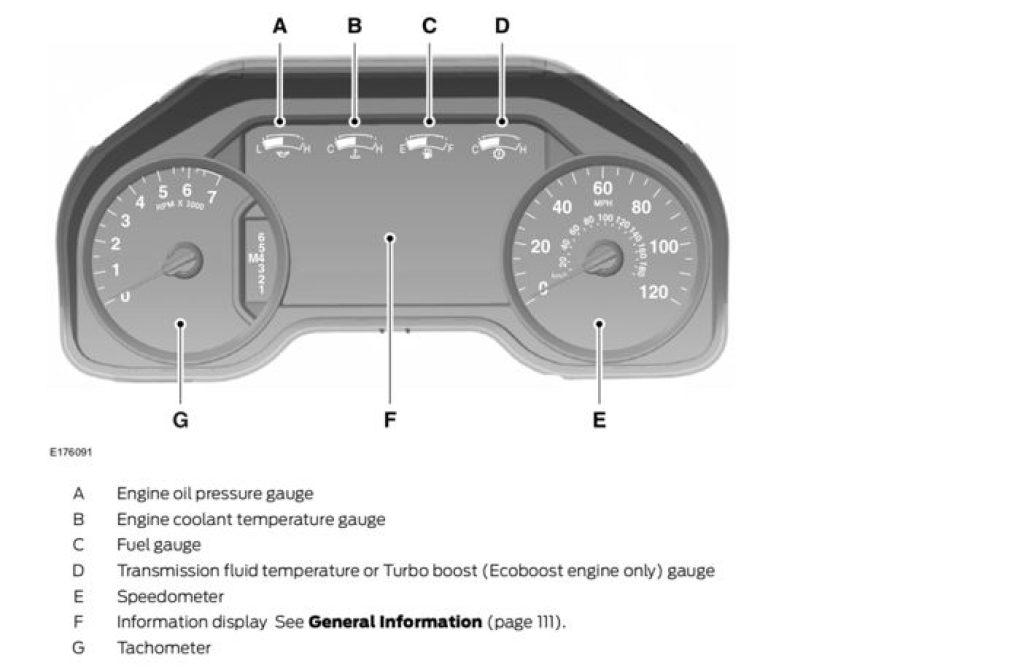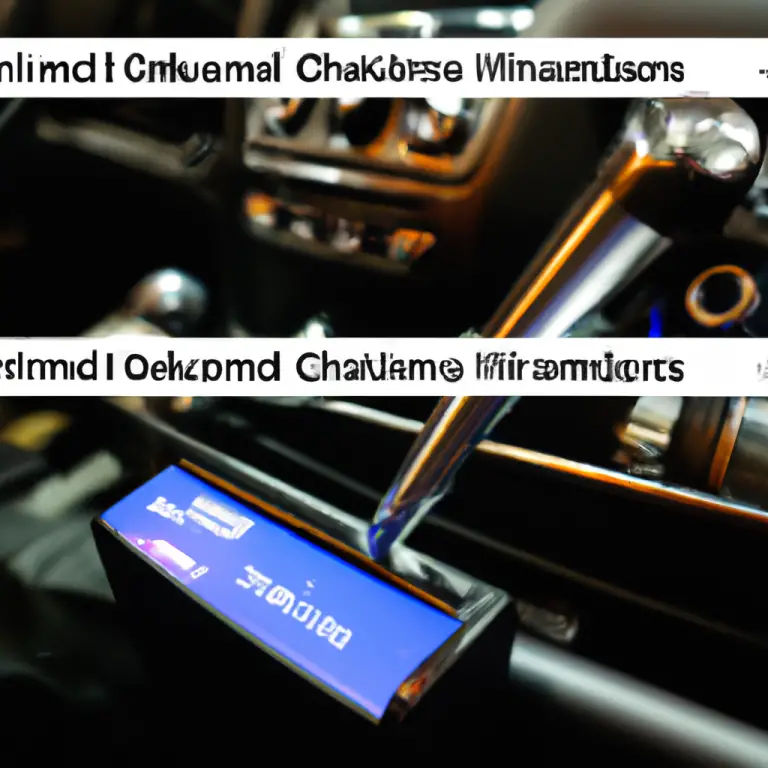Ford F150 Dashboard Gauges Meaning
The Ford F150 dashboard gauges are instruments that provide real-time readings of the vehicle’s performance, including engine RPM, engine temperature, fuel level, battery voltage, oil pressure, and speed.
Understanding the meanings behind each gauge is important for monitoring the vehicle’s health and responding to any potential issues.
The Ford F150 is a popular pickup truck known for its durability and versatility.
Like all vehicles, it is equipped with a dashboard to provide the driver with important information about the vehicle’s performance.
Related Article: Hill Descent Control Fault F150
The dashboard gauges are the instruments that give real-time readings of various aspects of the vehicle’s performance.
Ford F-150: What All Those Dash Lights Really Mean
The Different Gauges on Ford F150 Dashboard
The Ford F150 dashboard gauges include the engine RPM gauge, engine temperature gauge, fuel gauge, battery voltage gauge, oil pressure gauge, and speedometer.
Each gauge has its own unique purpose and provides valuable information to the driver.
6 The Meanings Behind the Ford F150 Gauges
1. Engine RPM Gauge
The engine RPM (revolutions per minute) gauge displays the speed at which the engine is running.
A high RPM reading indicates that the engine is working hard, while a low RPM reading means that the engine is running smoothly and efficiently.
2. Engine Temperature Gauge
The engine temperature gauge displays the temperature of the engine coolant.
A normal reading should be in the middle or slightly above the midpoint. If the gauge is reading hot, it could indicate a problem with the engine or cooling system.
3. Fuel Gauge
The fuel gauge displays the amount of fuel in the gas tank.
The needle should stay in the green area of the gauge, indicating that there is enough fuel for normal operation.
If the needle drops into the yellow or red area, it’s time to refuel.
4. Battery Voltage Gauge
The battery voltage gauge displays the amount of electrical power being generated by the battery.
A reading of around 12.5 volts indicates a fully charged battery, while a reading of around 11.5 volts indicates that the battery is running low.
5. Oil Pressure Gauge
The oil pressure gauge displays the pressure of the engine oil.
A normal reading should be in the middle or slightly above the midpoint. If the gauge is reading low, it could indicate a problem with the engine oil system.
6. Speedometer
The speedometer displays the vehicle’s speed in miles per hour.
The needle should stay within the speed limit range while driving.
How to Read the Ford F150 Dashboard Gauges
To properly read the Ford F150 dashboard gauges, it is important to understand their meanings and how they work. The dashboard gauges of the Ford F150 include the speedometer, tachometer, fuel gauge, and temperature gauge, among others. Each gauge provides essential information to the driver about the performance and condition of the vehicle. It is also important to regularly check the ford f150 rear ends, as they can affect the handling and safety of the vehicle. Understanding the dashboard gauges and regularly inspecting all aspects of the truck will help ensure a safe and efficient driving experience.
Always pay attention to the readings and respond appropriately if any readings are outside of the normal range.
Importance of Understanding the Ford F150 Dashboard Gauges
Understanding the Ford F150 dashboard gauges is important for a number of reasons:
It helps the driver monitor the health of the vehicle and respond to any potential issues in a timely manner.
It can also help the driver improve their driving habits and make the most of their vehicle’s performance.
Common Issues with Ford F150 Dashboard Gauges
resolve the following common issues with the Ford F150 dashboard gauges:
Inaccurate Fuel Gauge:
- 1: Check the fuel tank for any debris or buildup that might be blocking the fuel sender.
- 2: Ensure that the fuel tank is properly grounded by checking the grounding wire.
- 3: If the problem persists, check the fuel gauge sender unit for any corrosion or damage.
- 4: If the fuel gauge sender unit is damaged, replace it with a new one.
Sticking Speedometer:
- 1: Check the speedometer cable for any kinks or damages.
- 2: Clean the speedometer cable and the drive gear inside the transmission to remove any debris.
- 3: Lubricate the speedometer cable with a high-temperature lubricant.
- 4: If the problem persists, replace the speedometer cable with a new one.
Flickering or Dead Dash Lights:
- 1: Check the dashboard light dimmer switch and ensure that it’s in the correct position.
- 2: Check the fuses for the dashboard lights and replace any blown fuses.
- 3: Check the wiring connections for the dashboard lights and ensure that they are properly connected.
- 4: If the problem persists, replace the dashboard light bulbs with new ones.
Faulty Engine Temperature Gauge:
- 1: Check the engine temperature sensor for any corrosion or damage.
- 2: Ensure that the engine temperature sensor is properly grounded by checking the grounding wire.
- 3: If the problem persists, replace the engine temperature sensor with a new one.
Note: It is always advisable to refer to the vehicle’s owner’s manual and consult with a professional mechanic before attempting any repairs.
See Also:
- Reset Ford F150 throttle reset procedure: Step-by-Step Guide
- Solving the Ford F150 Radiator Fan Constantly Running Issue
- Ford F150 Computer Module Location
How to Troubleshoot Ford F150 Dashboard Gauges
Check the Fuse:
The first step in troubleshooting dashboard gauges is to check the fuse. A blown fuse can cause the gauges to stop working. To check the fuse, locate the fuse box in the Ford F150 and look for the fuse labeled “Instrument Panel.” If the fuse is blown, replace it with a new one of the same rating.
Verify the Power Supply:
Another common cause of dashboard gauges not working is a lack of power. To verify the power supply, check the battery terminals and make sure they are clean and tight. Additionally, make sure that the alternator is functioning properly and charging the battery.
Test the Wiring:
If the gauges are still not working after checking the fuse and power supply, the next step is to test the wiring. Use a multimeter to check for continuity in the wiring between the gauges and the engine control module. If you find a broken wire or another issue with the wiring, repair or replace it as necessary.
Check the Engine Control Module:
If the wiring is okay, the next step is to check the engine control module (ECM). The ECM is responsible for sending signals to the gauges, so if it is not functioning properly, the gauges will not work. To check the ECM, use a diagnostic tool to run a system scan and look for any error codes.
Replace the Gauges:
If all of the above steps have been completed and the gauges are still not working, it may be time to replace them. This can be a relatively straightforward process, but it is important to use high-quality replacement gauges that are designed specifically for the Ford F150.
Note: You should be able to resolve the most common issues with Ford F150 dashboard gauges. If you are unsure about any of the steps or if the gauges continue to not work, it is best to seek the assistance of a professional mechanic.
When to Seek Professional Help with Ford F150 Dashboard Gauges
- If you are experiencing issues with your Ford F150 dashboard gauges and cannot troubleshoot the problem on your own, it’s essential to seek professional help.
- A professional mechanic can diagnose the issue and provide a solution.
- Neglecting to address problems with the dashboard gauges can lead to further issues and potentially dangerous driving conditions.
Ford F150 Transmission Temperature Gauge
Assuming you would like a blog post discussing the Ford F-150’s transmission temperature gauge: The Ford F-150 comes equipped with a handy transmission temperature gauge, located on the instrument cluster near the speedometer.
This is a great feature for monitoring your truck’s transmission temperature and can help prevent potential damage from overheating.
Here’s how it works: The transmission temperature sensor monitors the temperature of the automatic transmission fluid (ATF). When the ATF gets too hot, it can break down and cause serious damage to your truck’s transmission.
The gauge will illuminate red when the ATF temperature gets too high, letting you know that it’s time to pull over and give your truck a rest.
So, if you see that red light on your dash, don’t ignore it! Find a safe place to pull over and let your truck cool down before continuing on your journey. By taking care of your truck and monitoring its vital systems, you can keep it running strong for many years to come.

FAQs
What is the purpose of the Ford F150 dashboard gauges?
The Ford F150 dashboard gauges provide real-time readings of the vehicle’s performance, including engine RPM, engine temperature, fuel level, battery voltage, oil pressure, and speed.
What should I do if I experience issues with my Ford F150 dashboard gauges?
If you experience issues with your Ford F150 dashboard gauges, check the fuses and sensors, check the wiring and connections, or calibrate the gauges if necessary. If the problem persists, seek professional help from a mechanic.
What is the importance of understanding the Ford F150 dashboard gauges?
Understanding the Ford F150 dashboard gauges is important for monitoring the health of the vehicle and responding to any potential issues. It can also help drivers improve their driving habits and make the most of their vehicle’s performance.
Conclusion
The Ford F150 dashboard gauges are an important aspect of the vehicle and provide valuable information to the driver. In addition to displaying speed, fuel levels, and engine temperature, the dashboard gauges also include indicators for the Ford 5.4 coolant sensor location. This provides the driver with real-time data on the temperature of the engine coolant, ensuring that they are aware of any potential issues with overheating. By having this information readily available, the driver can take the necessary precautions to maintain the optimal performance and safety of the vehicle.
Understanding the meanings behind each gauge and how to properly read them can help drivers monitor the health of their vehicle and respond to any potential issues.
If you experience any problems with the gauges, seek professional help for a safe and reliable driving experience.



